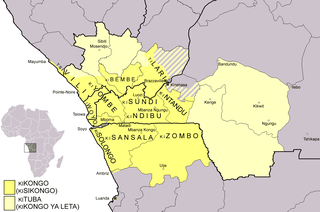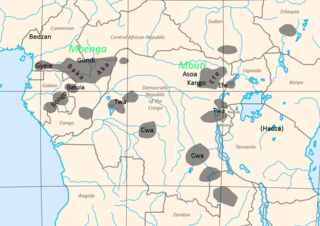Related Research Articles

Kongo or Kikongo is one of the Bantu languages spoken by the Kongo people living in the Democratic Republic of the Congo, the Republic of the Congo, Angola and Gabon. It is a tonal language. It was spoken by many of those who were taken from the region and sold as slaves in the Americas. For this reason, while Kongo still is spoken in the above-mentioned countries, creolized forms of the language are found in ritual speech of Afro-American religions, especially in Brazil, Cuba, Puerto Rico, Dominican Republic and Haiti. It is also one of the sources of the Gullah language and the Palenquero creole in Colombia. The vast majority of present-day speakers live in Africa. There are roughly seven million native speakers of Kongo, with perhaps two million more who use it as a second language.

The Mbuti people, or Bambuti, are one of several indigenous pygmy groups in the Congo region of Africa. Their languages are Central Sudanic languages and Bantu languages.
Myene is a cluster of closely related Bantu varieties spoken in Gabon by about 46,000 people. It is perhaps the most divergent of the Narrow Bantu languages, though Nurse & Philippson (2003) place it in with the Tsogo languages (B.30). The more distinctive varieties are Mpongwe (Pongoué), Galwa (Galloa), and Nkomi.
The Nyanga language is a language spoken by the Nyanga people in Kivu province, north-eastern Democratic Republic of the Congo. Speaker estimates range from 27,000 to 150,000. Many of the Nyanga speak Congo Swahili, the dominant regional lingua franca, as a second language. Nyanga is a Bantu language. Most of the (scarce) linguistic research conducted on Nyanga has been based on the materials published by Biebuyck and Mateene.
Ha, also known with the Bantu language prefix as Giha, Ikiha, or Kiha, is a Bantu language spoken by the Ha people of the Kigoma Region of Tanzania, spoken on the eastern side of Lake Tanganyika up to the headwaters of the Mikonga. It is closely related to the languages of Rwanda and Burundi; neighboring dialects are reported to be mutually intelligible with Kirundi.

The Kwasio language, also known as Ngumba / Mvumbo, Bujeba, and Gyele / Kola, is a language of Cameroon, spoken in the south along the coast and at the border with Equatorial Guinea by some 70,000 members of the Ngumba, Kwasio, Gyele and Mabi peoples. Many authors view Kwasio and the Gyele/Kola language as distinct. In the Ethnologue, the languages therefore receive different codes: Kwasio has the ISO 639-3 code nmg, while Gyele has the code gyi. The Kwasio, Ngumba, and Mabi are village farmers; the Gyele are nomadic Pygmy hunter-gatherers living in the rain forest.
Baka is a dialect cluster of Ubangian languages spoken by the Baka Pygmies of Cameroon and Gabon. The people are ethnically close to the Aka, the two together called the Mbenga (Bambenga), but the languages are not related, apart from some vocabulary dealing with the forest economy, which suggests the Aka may have shifted to Bantu, probably 15000 people have shifted.
Asoa, also known as Asua, Asuae, Asuati, or Aka, is a Central Sudanic language spoken by the Mbuti Pygmies known as the Asua. It is closely related to the Mangbetu language, and the Asua live in association with the Mangbetu people, among others. It is the only distinctive Pygmy language in the east.
Fipa is a Bantu language of Tanzania. It is spoken by the Fipa people, who live on the Ufipa plateau in the Rukwa Region of South West Tanzania between Lake Tanganyika and Lake Rukwa. The ethnic group of the Fipa people is larger than the group of Fipa language speakers. On the Tanzanian side, people who speak Mambwe-Lungu may identify as Fipa and consider their language to be a dialect of Fipa. Lungu and Mambwe are also spoken in Zambia where they are considered languages and their speakers are considered to be ethnic groups in their own right, although linguists consider Lungu and Mambwe to be dialects of a single language. There are three dialects: Milanzi, Kwa (Ichikwa) and Nkansi.
Mijikenda is a Bantu dialect cluster spoken along the coast of East Africa, mostly in Kenya, where there are 1.9 million speakers but also in Tanzania, where there are 100,000 speakers. The name Mijikenda means "the nine settlements" or "the nine communities" and refers to the multiple language communities that make up the group. An older, derogatory term for the group is Nyika which refers to the "dry and bushy country" along the coast.
The Kango (Bakango), also known as the Batchua and Mbuti-Sua, are an Mbuti pygmy people of the Ituri forest. They speak a Bantu language, Bila, apparently in two dialects, northern Sua and southern Kango.

The Congo Pygmies are those "forest people" who have, or recently had, a hunter-gatherer economy and a simple, non-hierarchical societal structure based on bands, are of short stature, have a deep cultural and religious affinity with the Congo forest and live in a generally subservient relationship with agricultural "patrons", with which they trade forest products such as meat and honey for agricultural and iron products.
The Bedzan people, also known as the Tikar, are a Pygmy people of Cameroon. The Bedzan community is primarily located in the village of Yoko, on the Tikar Plain, in the Mbam-et-Kim department of Centre Region, and is estimated at between 250 and 1,200. They live at the interface of the forest and the savannah, and their language is a dialect of Tikar, which is related to the Bantu languages.
Njebi is a Bantu language spoken in Gabon and the Republic of Congo.
Iyasa is a Bantu language spoken in Cameroon and Equatorial Guinea by the Iyasa and Ndowe coastal fishing peoples. It is also spoken by Pygmies, perhaps Babongo, in Gabon. Approximately 3,000 people speak Iyasa, though some note that this number may be an overestimation.

The Twa are a group of indigenous African Pygmy tribes.
The Twa of the Kafue Flats wetlands of Zambia are one of several fishing and hunter-gatherer castes living in a patron-client relationship with farming Bantu peoples across central and southern Africa.

The African Pygmies are a group of ethnicities native to Central Africa, mostly the Congo Basin, traditionally subsisting on a forager and hunter-gatherer lifestyle. They are divided into three roughly geographic groups:
Kwakum is classified as belonging to the Bantu subgroup A90 (Kaka) of the Zone “A” Bantu languages, and specifically labelled A91 by Guthrie. According to one of the newest updates to the Bantu classification system, other languages belonging to this subgroup are: Pol (A92a), Pɔmɔ (A92b), Kweso (A92C) and Kakɔ (A93). The Kwakum people refer to themselves as either Kwakum or Bakoum. However, they say that the "Bakoum" pronunciation only began after the arrival of Europeans in Cameroon, though it is frequently used today. Kwakum is mainly spoken in the East region of Cameroon, southwest of the city Bertoua.
The Bakoya are pygmies, earlier known as Négrilles or Babinga, who inhabitant the rainforest between Cameroon and the Great Lake region of the Congo Basin in Central Africa. Since the 1930s, the Bakoya, in particular, have settled in Gabon in the Ogooue-Ivindo Province, in the northeastern region of the country. Similar minority groups are the Babongo and the Baka pygmies. Before they adapted to the agricultural practices in the new settlements in Gabon along the flanks of the road, Bakoya were “semi-nomadic hunter-gatherers” like the other forest-dwelling pygmies; they resided in small huts. The word 'Pygmee' is a French coinage, adopted by the Gabonese. They are the earliest inhabitants of the forest and are nomadic hunter gatherers.
References
- ↑ Bila at Ethnologue (18th ed., 2015)
Kango–Sua at Ethnologue (18th ed., 2015) - ↑ Jouni Filip Maho, 2009. New Updated Guthrie List Online
- ↑ L'Apare est un ruisseau, affluent de l'Ituri en région des Bantous Babali. La route qui relie Bafwasende à Bomili traverse le village, où réside ce groupe de Pygmées devenus sédentaires. Dans la documentation de l'expédition de 1929 et de 1935, ils étaient désignés sous le nom de Basua [page] Babali aux Bango wa mugwase (ou Pygmées de forêt). Après l'expédition de 1949–50, l'auteur préfère substituer à ces deux appellations, données par les Babali, leurs propres noms : les Pygmées de forêt désignent ceux de village du nom de Balioli (=Belueli) (sing. Dioy) et vice-versa ceux-ci désignent les Pygmées de forêt du nom de Bango (sing. Mwango).
- Serge BAHUCHET, 2006. "Languages of the African Rainforest « Pygmy » Hunter-Gatherers: Language Shifts without Cultural Admixture." In Historical linguistics and hunter-gatherers populations in global perspective. Leipzig.
- Kutsch Lojenga, Constance. 2003. Bila (D32). In Nurse, Derek and Philippson, Gérard (eds.), The Bantu languages, 450-474. London & New York: Routledge.